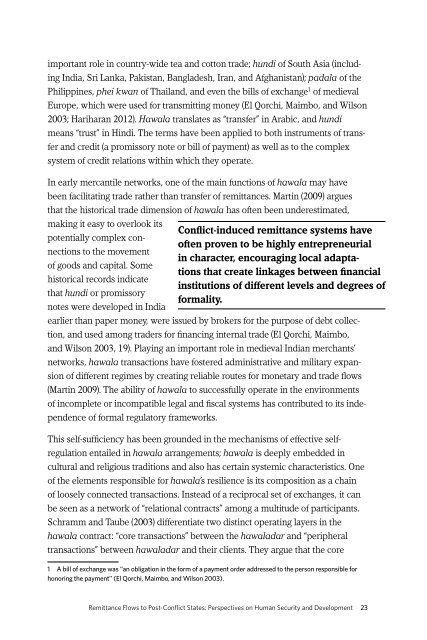Pardee-CFLP-Remittances-TF-Report
Pardee-CFLP-Remittances-TF-Report
Pardee-CFLP-Remittances-TF-Report
Create successful ePaper yourself
Turn your PDF publications into a flip-book with our unique Google optimized e-Paper software.
important role in country-wide tea and cotton trade; hundi of South Asia (includingIndia, Sri Lanka, Pakistan, Bangladesh, Iran, and Afghanistan); padala of thePhilippines, phei kwan of Thailand, and even the bills of exchange 1 of medievalEurope, which were used for transmitting money (El Qorchi, Maimbo, and Wilson2003; Hariharan 2012). Hawala translates as “transfer” in Arabic, and hundimeans “trust” in Hindi. The terms have been applied to both instruments of transferand credit (a promissory note or bill of payment) as well as to the complexsystem of credit relations within which they operate.In early mercantile networks, one of the main functions of hawala may havebeen facilitating trade rather than transfer of remittances. Martin (2009) arguesthat the historical trade dimension of hawala has often been underestimated,making it easy to overlook itspotentially complex connectionsto the movementof goods and capital. Somehistorical records indicatethat hundi or promissorynotes were developed in IndiaConflict-induced remittance systems haveoften proven to be highly entrepreneurialin character, encouraging local adaptationsthat create linkages between financialinstitutions of different levels and degrees offormality.earlier than paper money, were issued by brokers for the purpose of debt collection,and used among traders for financing internal trade (El Qorchi, Maimbo,and Wilson 2003, 19). Playing an important role in medieval Indian merchants’networks, hawala transactions have fostered administrative and military expansionof different regimes by creating reliable routes for monetary and trade flows(Martin 2009). The ability of hawala to successfully operate in the environmentsof incomplete or incompatible legal and fiscal systems has contributed to its independenceof formal regulatory frameworks.This self-sufficiency has been grounded in the mechanisms of effective selfregulationentailed in hawala arrangements; hawala is deeply embedded incultural and religious traditions and also has certain systemic characteristics. Oneof the elements responsible for hawala’s resilience is its composition as a chainof loosely connected transactions. Instead of a reciprocal set of exchanges, it canbe seen as a network of “relational contracts” among a multitude of participants.Schramm and Taube (2003) differentiate two distinct operating layers in thehawala contract: “core transactions” between the hawaladar and “peripheraltransactions” between hawaladar and their clients. They argue that the core1 A bill of exchange was “an obligation in the form of a payment order addressed to the person responsible forhonoring the payment” (El Qorchi, Maimbo, and Wilson 2003).Remittance Flows to Post-Conflict States: Perspectives on Human Security and Development 23


